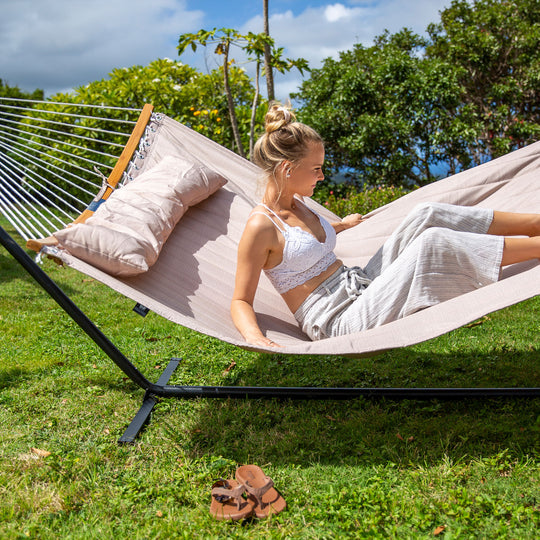SUNCREAT - Jul. 11th 2024
Can You Leave a Hammock Chair Outside?
Hammock chairs are beloved for their comfort and aesthetic appeal, making them a popular choice for both indoor and outdoor spaces. However, if you’re considering placing your hammock chair outdoors for an extended period, you may wonder whether it can withstand the elements. The answer to this question depends on various factors, including the chair’s material, the weather conditions it will face, and the maintenance you’re willing to invest in.wind. But are they really worth adding to your home? Let's explore the benefits and potential drawbacks.
Material Considerations
The material of your hammock chair plays a crucial role in determining its suitability for outdoor use. Common materials include cotton, polyester, nylon, canvas, and woven ropes, each with its own advantages and limitations.
1. Cotton
Cotton hammock chairs are soft and comfortable, making them a favorite for indoor use. However, cotton is not highly resistant to moisture and UV rays. When exposed to rain and sunlight for extended periods, cotton can fade, mold, and weaken. For this reason, cotton hammock chairs are better suited for indoor settings or outdoor areas with protection from the elements, such as covered patios.
2. Polyester and Nylon
Polyester and nylon are synthetic materials known for their durability and weather resistance. These materials can withstand exposure to sunlight and rain much better than cotton, making them more suitable for outdoor use. However, even with these materials, it’s advisable to provide some protection during extreme weather conditions, such as heavy rain or prolonged exposure to intense sunlight, to extend the chair’s lifespan.
3. Canvas
Canvas is a sturdy material that offers a good balance between comfort and durability. It’s more weather-resistant than cotton but still requires some care. Over time, continuous exposure to harsh weather conditions can cause canvas to fade or wear down. Protecting canvas hammock chairs with a cover when not in use can help maintain their appearance and durability.
4. Woven Ropes
Hammock chairs made from woven ropes, often using polyester or nylon, are well-suited for outdoor use. The open weave allows for excellent airflow, which helps prevent water from accumulating and reduces the risk of mildew. These chairs are a great choice for outdoor spaces, but it’s still important to regularly check the ropes for signs of wear and tear.
Weather Considerations and Protective Measures
When leaving a hammock chair outside, it’s essential to consider the impact of weather conditions, even if the chair is made from weather-resistant materials.
1. Sunlight
Prolonged exposure to sunlight can cause the materials of a hammock chair to degrade over time, leading to fading and brittleness. To protect your chair, consider using a UV-resistant cover when the chair is not in use or placing it in a shaded area.
2. Rain
Rain can be particularly damaging to hammock chairs, especially those made from cotton or canvas. Moisture can lead to mold and mildew growth, which can weaken the fabric and create an unpleasant odor. To protect against rain, bring the chair indoors during storms or use a waterproof cover.
3. Wind
Strong winds can cause significant stress on the hammock chair’s attachment points and material. In high wind conditions, it’s advisable to take the chair down to prevent it from being damaged or torn from its mountings.
Maintenance and Care
Regular maintenance is key to ensuring the longevity of your hammock chair, especially when it’s kept outdoors.
1. Cleaning
Regular cleaning helps maintain the appearance and comfort of your hammock chair. For cotton and canvas chairs, a gentle wash with warm water and mild detergent is recommended. Polyester and nylon chairs can often be cleaned with a damp cloth. Always ensure the chair is fully dry before storing it to prevent mold growth.
2. Mold Prevention
In damp environments, mold can be a persistent issue. Using mold-resistant sprays or adding mold inhibitors to your cleaning routine can help keep your hammock chair free from mold.
3. Storage
When not in use, it’s best to store your hammock chair in a dry, well-ventilated area, away from direct sunlight and moisture. If storing the chair is not an option, using a high-quality protective cover can provide a similar level of protection..
So, can you leave a hammock chair outside? The answer is yes, but with some considerations. The material of the chair, the local weather conditions, and your commitment to maintenance will all influence how well your hammock chair holds up outdoors. For those who are willing to invest in regular care and take precautions during extreme weather, a hammock chair can be a delightful addition to any outdoor space, providing comfort and style throughout the seasons.







